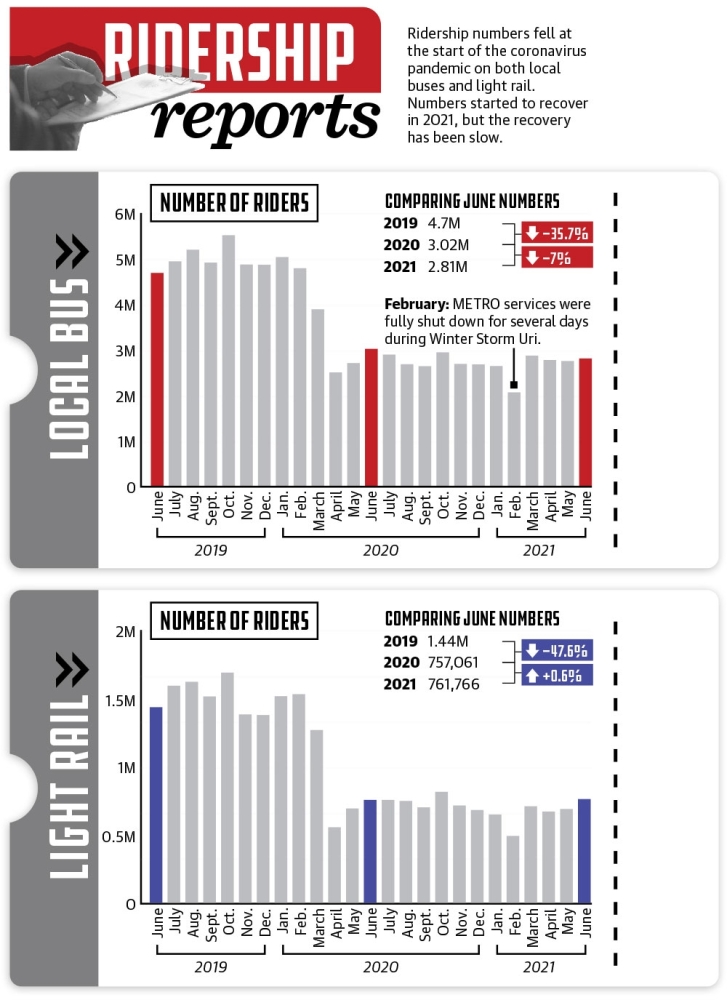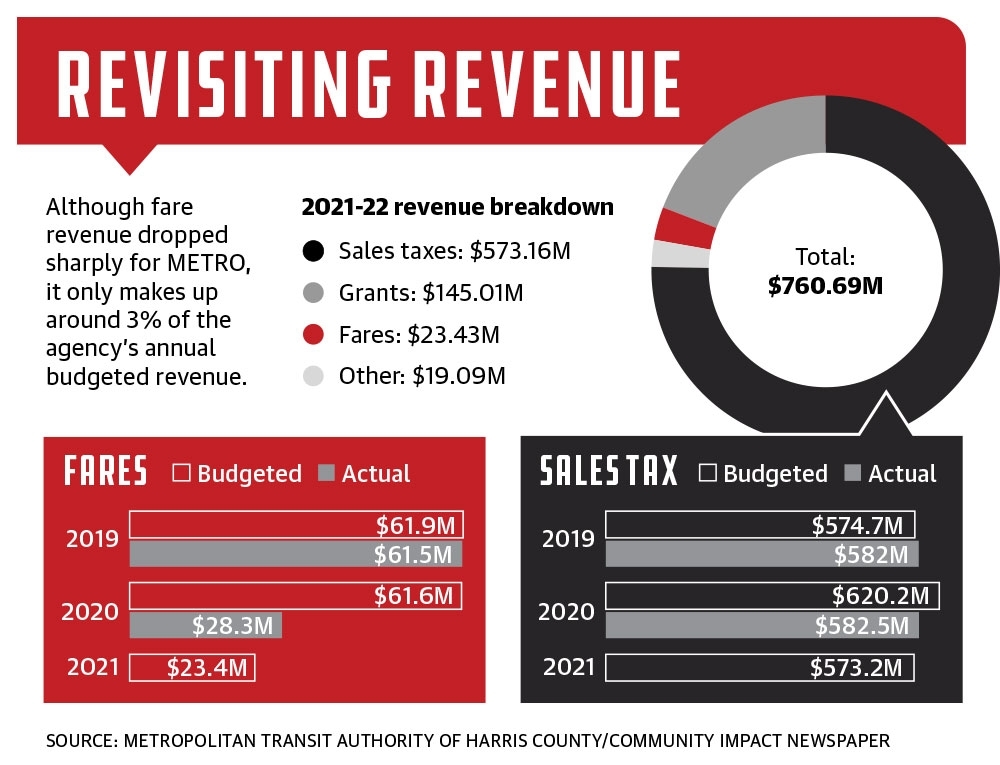Ridership numbers and revenues are down for the Metropolitan Transit Authority of Harris County, but the real story that emerged from the pandemic was one of how essential the agency’s services are for people who rely on them, METRO CEO Tom Lambert said.
“We’ve been carrying about 140,000 riders a day,” Lambert said. “That just really demonstrated the essential service that transit provides to the broader community. That’s something that I think we always knew but has now clearly been demonstrated.”
METRO ridership reports show monthly local bus ridership fell by 40% between June 2019 and June 2021, a loss of roughly 1.9 million riders. Over that same time frame, light-rail ridership was down 47%.
Meanwhile, revenue from ridership fell from $61.5 million in fiscal year 2019 to $23.4 million in FY 2021. However, most of METRO’s revenue comes from sales taxes—more than 75% in the agency’s fiscal year 2021-22 budget. Sales tax revenue saw a much smaller drop between 2019 and 2021, while revenue from federal grants rose.
The pandemic began soon after voters approved a $3.5 billion bond referendum for METRO in November 2019 to support METRONext, the agency’s 20-year vision plan. The bond was designed around a long-term plan to execute more than 500 miles of improvements through 2040, including several new routes that will complete connections in the Heights, River Oaks and Montrose areas.
Even with the pandemic-spurred ridership decline, local transportation experts said fulfilling those plans remains critical for the future of Houston’s transportation network.
“This is not the time to be questioning whether or not we move forward with things,” said Andrea French, executive director of the Transportation Advocacy Group Houston. “This is a time to definitely move swiftly and make sure that we’re staying connected for our economy and for our quality of life.”
Rapid and reliable
The METRONext plan hits on various methods of improving the public transit system in Houston, including light-rail extensions, local bus route additions, the development of new park and ride infrastructure, and systemwide improvements to bring every METRO facility in line with the Americans with Disabilities Act.
About $3.5 billion will be funded through the 2019 bond referendum, Lambert said. Another $500 million will come from METRO’s budget, and the agency is seeking $3 billion in funding from the federal government.
Some of the first large-scale projects to move forward involve connecting existing transit centers with light-rail hubs through the use of bus rapid transit routes, a type of dedicated bus service officials have described as “light rail on rubber tires.”
The first of several planned rapid lines began prior to the 2019 bond referendum and was completed in August 2020. Known as the Silver Line, the service connects the Lower Uptown Transit Center to the Northwest Transit Center through the Galleria area.
A proposed University Corridor bus rapid transit line will intersect with the Silver Line along a pathway that will also connect with multiple transit centers; park and ride facilities; local bus routes; and METRO’s red, green and purple light-rail lines.
Riders will be able to take the line from the Westchase area to the Wheeler Transit Center in Midtown and north to the Tidwell Transit Center, a route that will include a number of stops around River Oaks and Montrose along Richmond Avenue.
“The way that it can transform how people make trips in the region is going to be mind boggling,” said project manager Priya Zachariah during a July presentation on the project.
The METRO board of directors identified the University Corridor as a project to accelerate, meaning a lot of the planning and design is being advanced in an effort to prepare the project for the federal grant process, METRO officials said. An environmental study could kick off later this year or early next year, and construction could start around 2025.
The success of the project will depend heavily on making sure it is pedestrian friendly, said Stephen Longmire, president of the First Montrose Commons Civic Association, a neighborhood preservation group. Longmire said he has been advocating for some form of an east-west corridor down Richmond Avenue for years, dating back to when METRO was exploring light rail in the area.
Instead of starting construction in Westchase and moving east, he urged METRO to start at the Wheeler Transit Center and go west. At the same time, METRO could make safety and security improvements, he said.
“If METRO wants to have good ridership ... they have to make sure the people can get to and from [stations] without getting run over,” he said.
Lessons learned

Even with those restrictions in place, monthly ridership totals never dropped below 2 million on local bus routes, according to METRO data. Tim Lomax, a senior research engineer with the Texas A&M Transportation Institute, said this is evidence of how important public transit is for essential workers, especially those who do not have cars.
“I think that the rapid bus routes they have on Westheimer and Bellaire are ones that will appeal to that market also,” Lomax said.
Lomax attributed the drop in ridership in part due to decreased employment in Houston’s downtown areas and the resulting lack of commuters. About 40%-50% of the people who worked in downtown Houston get there by carpooling or bus, he said.
However, even if offices permanently reduce the number of days they require employees to be on-site, many workers will rely on public transit to get around, he said.
“Transit’s role is they have the ability to provide a faster, managed commute,” Lomax said. “There’s still going to be a need for that.”
But the plan cannot focus solely on traditional commuters, said Ines Sigel, interim executive director of LINK Houston, a public transit advocacy group that calls for equity in transportation planning. Improving the reliability and accessibility of local bus routes is something that should be done in the near term that could later support longer-range projects such as the University Corridor as they come to fruition, she said.
“We need to use public transit for other trips as well ... getting to grocery stores, health care and even to social outings,” Sigel said. “We need to really invest in and create a transit system that is viable for all of these trips and not just in terms of commuting.”
Because the METRONext plan was devised as a long-term vision, Lambert said timelines of individual projects were not significantly affected by the pandemic. From the start, projects were not intended to begin until financing was secured, he said.
Other major projects include a light-rail extension to Hobby Airport and the Inner Katy Corridor, a dedicated rapid bus route along I-10 into Downtown that could be elevated in some areas and could break ground in 2023.

The bigger picture
On top of providing people with better connections and more reliable service, METRONext can also be seen as part of a bigger vision in Houston to create more dense “urban villages,” Lomax said, where mixed-use developments are supported by a stronger transportation network.
Bus rapid transit and light rail are particularly useful in facilitating those kinds of developments because they can attract people who would otherwise not consider public transit as an option, Lomax said. In this context, improving the reliability of public transit is key, he said.
“If the [bus] stops 20 times before you get to where your destination is, that’s a burden,” he said. “If you don’t have a choice, that’s the way you get there. But if you’re trying to attract people or trying to attract changes in urban character, you really need something that feels more like a car.”
Meanwhile, a $1 trillion infrastructure bill—known as the Bipartisan Infrastructure Investment and Jobs Act—is working its way through Congress. Although the bill focuses a lot of money on highway projects, French said the most recent iteration puts a more intentional focus on public transportation as well. If the bill passes, French said it would allow entities such as METRO more ability to start planning some of their more ambitious public transportation projects.
“It frees up a lot of the blockage, for lack of a better word, that you have with projects and planning,” she said. “That’s what the infrastructure bill has for transit agencies—the opportunity to think beyond what’s right in front of you.”
As of press time, the bill had been passed by the U.S. Senate and was being heard in the House of Representatives. METRO would still have to go through the application process to receive funding.
The University Corridor is one of the top candidates to draw down funding from that bill if it passes, Lambert said, as would a proposed light-rail extension from Houston’s east end to the Hobby Airport.
“We look forward to what Congress will ultimately decide and making sure that we’re prepared to bring those funds back to what we just found out is the second-fastest growing region in the country,” he said.





